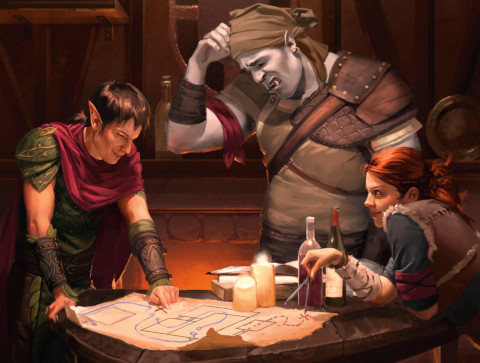5th edition Dungeons and Dragons has a bit of a rough patch with its skill checks model. Given the variability of a d20, all or nothing skill checks can be a fairly harsh mechanic. Indeed, there’s some evidence all or nothing checks is not the designers intent. The DMG Chapter 8 provides some alternative methods to consider with skill resolution under Resolution and Consequences which all hinge on a single die roll mechanic. In cases, there may be some utility using a progressive success or failure system instead of a single checks. Particularly in non-combat encounters, it is best to build skill checks in a way to build tension from failure rather than a collapse. DMDavid sparked a thought after a specific example posted on twitter, how to handle falling with failed climbing checks. Progressive failure and rising tension meshes well with the Thrilling Heroics Rules I posted awhile back. In fact, it compliments it enough that I thought it useful to post some examples here.
Before I dig too deep, I intend this to be used as another option mixed in with some of the excellent options presented in Resolution and Consequences in Chapter 8 of the DMG.
Progressive Rolls in a Nutshell
The core game principle is fairly simple, wherever possible the DM can create more tension in a game by progressing the tension with failed skill rolls. I think in these cases a rule of three model would seem to work. Simply that is:
- 1st Failure: No progress
- 2nd Failure: Unable to advance without help or change.
- 3rd Failure: Consequences
At each stage along the way, the DM should increase the stakes more. Players can turn the failure around by changing something or accepting some additional risk. The idea is to keep agency in the hands of the the players. In this way, they are able to make decisions and manage their risk as the tension builds.

Why this is Useful
Single roll success or failure models can be bad when failure is catastrophic. For instance, a climbing check that causes you to fall if you fail the roll by more than five. This is a bad model because the variability of a d20 is so high that putting everything onto a single roll is a bad idea. This is particularly bad if failure means they plummet to their death.
Instead, let’s use an example with the rule of three model.
Example with Climb Check: The first athletics fail results in no progress. The second failure means the character is stuck and cannot progress without help or significant risk. At this point something needs to change to allow them to progress, meaning either another character climbs over to help them, or some new spell or equipment comes into play. Alternatively, the character can now choose to try to climb again, but this time the risk is if they fail, they fall!
Example with a Stealth Check: The first stealth failure results in the character not being able to move without revealing themselves. The second failure means they are stuck and others are alerted enough to begin to investigate. At this point something else needs to happen, perhaps another character creates a distraction or they use a spell of some sort. Alternatively, the character can risk one last stealth check, perhaps at disadvantage, with the risk of raising the alarm.
General Use
You can extend this thinking to many types of skill checks. For instance, investigations don’t progress and getting unstuck risks offending, alerting, or misunderstanding something. Disabling traps might risk sealing a passageway, alerting nearby creatures, or triggering it at an auto failed save or critical damage. It can vary by skill but it’s worth thinking about, particularly for scenarios where combat is not the main focus.
Obviously, these are fuzzy situations, as with most rulings in 5th edition, the DM has to choose the right method for determining outcome based on pacing and the situation. Too often though, DMs reach for the pass/fail mechanic. There’s some work to do on the DMs part to determine what a success means, is it a reset back to zero, does it just progress the character back to being stuck? Are the risky third rolls made at disadvantage? There’s no way to tell, and this part of the craft of the DM as they reach for the proper tool to manage tension in the game. In my own case, remembering to do it in the midst of trying to keep the game moving can work against me, but if you have a situation where you want to build tension around non-combat action in game, a DM might consider this method of resolution.
Update 1/6/2021
Several folks have linked Matt Colville’s video “Many Fail States” which compliments this as well. Thank you so much for the folks that reached out to send me this link. Adding the video here and recommend you check it out for additional thoughts on the topic.